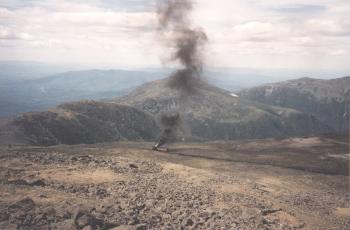Many years ago my fiancé (now wife) and I traveled through northern New England for two weeks. That was long ago. We actually tent-camped our way through a string of rustic state parks with few amenities. It changed to Bed-and-Breakfasts Inns after our marriage. Then it changed again to whatever hotel happened to have an indoor pool and a free breakfast buffet once the kids came along. Imagine though, a time when I once trampled through the wilderness without regard to creature comforts.

One of our stops delivered us to the top of Mount Washington, the highest point in the state of New Hampshire (map). Indeed it’s higher than anywhere else in the northeastern United States: 1,917 metres (6,288 feet). There, the observatory atop the mountain claims to be the “Home of the World’s Worst Weather”. Even so it didn’t live up to its fierce reputation during our visit. We found the summit picture postcard perfect. Not that this has anything to do with today’s subject.
Encountering the Cog
We saw a terrible column of black smoke rising from the valley. What could possibly burn on the barren rock above the tree line? It moved closer. Soon enough we saw that it belching from an ancient machine. A mighty hissing steam engine pushed a passenger car.
And that’s when we discovered the Mount Washington Cog Railway

I didn’t know anything about the cog railway prior to our visit. I will take a ride if I ever return, now wiser and lazier after the passage of more years than I’d like to admit.
The Washington Mountain Cog Railway is an institution. It was the very first mountain cog railway ever constructed. So of course it continues to be the oldest by definition. Tourists started taking the railway safely to the summit of Mount Washington in 1869, pushed along nearly unimaginable gradients up to 37%.
How it Works

Generically it’s a “rack and pinion” railway, a technology particularly suited to steep mountainous terrain. The rack is a toothed track strung along a rail bed. The pinion is a cog wheel that aligns with the rack. It’s easier to picture than describe. They’ve been deployed worldwide in places where ordinary trains would spin their wheels on their tracks.
United Kingdom

A rack and pinion design has worked efficiently for over a century at Snowdon, the highest peak in the British Isles outside of Scotland (map). The Snowdon Mountain Railway rises to a 1,085 m (3,560 ft) summit from Llanberis, a village in Gwynedd, North Wales. It is the only example of a cog railway in the United Kingdom.
Reputedly the SMR served as an inspiration for the fictional Culdee Fell Railway, which in turn spun off into the whole Thomas the Tank Engine phenomenon. That probably doesn’t matter much to you unless your household went through a Thomas the Tank Engine phase, as mine did when our kids were younger.
Australia
Not every cog railroad dates back to the Nineteenth or earliest days of the Twentieth Century. The technology continues to fill a small but important niche in the modern world.
Perisher is a large ski resort in the Snowy Mountains of New South Wales, Australia. The only road into the area was frequently blocked by the same weather that makes the resort so attractive, an overabundance of snow. The proprietors dug a tunnel through a mountain to provide an alternate path, and within the tunnel they constructed an underground rack railway. Perisher Skitube Alpine Rail began delivering skiers to the resort in 1987.
India

A segment of the Nilgiri Mountain Railway in Tamil Nadu, India, is a cog railway climbing up through thick, uninhabitable jungle slopes (map). The rack-and-pinion portion of the railway running from Kallar to Coonoor includes “208 curves and 13 tunnels, and 27 viaducts” as noted by UNESCO when it added Nilgiri to the Mountain Railways of India World Heritage Site. It has operated here since 1908.
Brazil

More accessible, yet also confronting the challenges of extreme topography, the Trem do Corcovado of Rio de Janeiro, Brazil, climbs to the top of Morro do Corcovado. This is the famous mountaintop crowned by the statue of Cristo Redentor — Christ the Redeemer — that is easily one of the most recognizable and iconic images of the nation (map)
There are other examples, but Cog railways are still a rather unusual phenomenon. Even so, a rack-and-pinion design is still the best technology for a very special set of circumstances. That hasn’t changed in more than a hundred and fifty years.

Leave a Reply